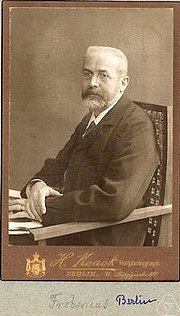Frobenius covariant: Difference between revisions
m MOS:ELLIPSES (via WP:JWB) |
|||
| (9 intermediate revisions by 7 users not shown) | |||
| Line 1: | Line 1: | ||
In [[Matrix (mathematics)|matrix theory]], the '''Frobenius covariants''' of a [[square matrix]] {{mvar|A}} are special polynomials of it, namely [[projection (linear algebra)|projection]] matrices ''A''<sub>''i''</sub> associated with the [[eigenvalue, eigenvector and eigenspace|eigenvalues and eigenvectors]] of {{mvar|A}}.<ref name=horn>Roger A. Horn and Charles R. Johnson (1991), ''Topics in Matrix Analysis''. Cambridge University Press, ISBN |
In [[Matrix (mathematics)|matrix theory]], the '''Frobenius covariants''' of a [[square matrix]] {{mvar|A}} are special polynomials of it, namely [[projection (linear algebra)|projection]] matrices ''A''<sub>''i''</sub> associated with the [[eigenvalue, eigenvector and eigenspace|eigenvalues and eigenvectors]] of {{mvar|A}}.<ref name=horn>Roger A. Horn and Charles R. Johnson (1991), ''Topics in Matrix Analysis''. Cambridge University Press, {{ISBN|978-0-521-46713-1}}</ref>{{rp|pp.403,437–8}} They are named after the mathematician [[Ferdinand Georg Frobenius|Ferdinand Frobenius]]. |
||
Each covariant is a [[projection (linear algebra)|projection]] on the [[eigenvalue, eigenvector and eigenspace|eigenspace]] associated with the eigenvalue {{math|''λ''<sub>''i''</sub>}}. |
Each covariant is a [[projection (linear algebra)|projection]] on the [[eigenvalue, eigenvector and eigenspace|eigenspace]] associated with the eigenvalue {{math|''λ''<sub>''i''</sub>}}. |
||
| Line 6: | Line 6: | ||
==Formal definition== |
==Formal definition== |
||
Let {{mvar|A}} be a [[diagonalizable matrix]] with |
Let {{mvar|A}} be a [[diagonalizable matrix]] with eigenvalues ''λ''<sub>1</sub>, ..., ''λ''<sub>''k''</sub>. |
||
The Frobenius covariant {{math|''A''<sub>''i''</sub>}}, for ''i'' = 1, |
The Frobenius covariant {{math|''A''<sub>''i''</sub>}}, for ''i'' = 1,..., ''k'', is the matrix |
||
:<math> A_i \equiv \prod_{j=1 \atop j \ne i}^k \frac{1}{\lambda_i-\lambda_j} (A - \lambda_j I)~. </math> |
:<math> A_i \equiv \prod_{j=1 \atop j \ne i}^k \frac{1}{\lambda_i-\lambda_j} (A - \lambda_j I)~. </math> |
||
It is essentially the [[Lagrange polynomial]] with matrix argument. If the eigenvalue ''λ''<sub>''i''</sub> is simple, then as an idempotent projection matrix to a one-dimensional subspace, {{math|''A''<sub>''i''</sub>}} has a unit [[Trace (linear algebra)|trace]]. |
It is essentially the [[Lagrange polynomial]] with matrix argument. If the eigenvalue ''λ''<sub>''i''</sub> is simple, then as an idempotent projection matrix to a one-dimensional subspace, {{math|''A''<sub>''i''</sub>}} has a unit [[Trace (linear algebra)|trace]]. |
||
| Line 18: | Line 18: | ||
The Frobenius covariants of a matrix {{mvar|A}} can be obtained from any [[eigendecomposition]] {{math|''A'' {{=}} ''SDS''<sup>−1</sup>}}, where {{mvar|S}} is non-singular and {{mvar|D}} is diagonal with {{math|''D''<sub>''i'',''i''</sub> {{=}} ''λ''<sub>''i''</sub>}}. |
The Frobenius covariants of a matrix {{mvar|A}} can be obtained from any [[eigendecomposition]] {{math|''A'' {{=}} ''SDS''<sup>−1</sup>}}, where {{mvar|S}} is non-singular and {{mvar|D}} is diagonal with {{math|''D''<sub>''i'',''i''</sub> {{=}} ''λ''<sub>''i''</sub>}}. |
||
If {{mvar|A}} has no multiple eigenvalues, then let ''c''<sub>''i''</sub> be the {{mvar|i}}th |
If {{mvar|A}} has no multiple eigenvalues, then let ''c''<sub>''i''</sub> be the {{mvar|i}}th right eigenvector of {{mvar|A}}, that is, the {{mvar|i}}th column of {{mvar|S}}; and let ''r''<sub>''i''</sub> be the {{mvar|i}}th left eigenvector of {{mvar|A}}, namely the {{mvar|i}}th row of {{mvar|S}}<sup>−1</sup>. Then {{math|''A''<sub>''i''</sub> {{=}} ''c''<sub>''i''</sub> ''r''<sub>''i''</sub>}}. |
||
If {{mvar|A}} has multiple |
If {{mvar|A}} has an eigenvalue ''λ''<sub>''i''</sub> appearing multiple times, then {{math|''A''<sub>''i''</sub> {{=}} Σ<sub>''j''</sub> ''c''<sub>''j''</sub> ''r''<sub>''j''</sub>}}, where the sum is over all rows and columns associated with the eigenvalue ''λ''<sub>''i''</sub>.<ref name=horn/>{{rp|p.521}} |
||
==Example== |
==Example== |
||
| Line 26: | Line 26: | ||
Consider the two-by-two matrix: |
Consider the two-by-two matrix: |
||
:<math> A = \begin{bmatrix} 1 & 3 \\ 4 & 2 \end{bmatrix}.</math> |
:<math> A = \begin{bmatrix} 1 & 3 \\ 4 & 2 \end{bmatrix}.</math> |
||
This matrix has two eigenvalues, 5 and −2; hence {{math| (''A'' |
This matrix has two eigenvalues, 5 and −2; hence {{math| (''A'' − 5)(''A'' + 2) {{=}} 0}}. |
||
The corresponding eigen decomposition is |
The corresponding eigen decomposition is |
||
| Line 36: | Line 36: | ||
\end{array} </math> |
\end{array} </math> |
||
with |
with |
||
:<math>A_1 A_2 =0 , \qquad A_1+A_2= I ~. |
:<math>A_1 A_2 = 0 , \qquad A_1 + A_2 = I ~.</math> |
||
Note {{math|tr''A''<sub>1</sub>{{=}}tr''A''<sub>2</sub>{{=}}1}}, as required. |
Note {{math|tr{{nnbsp}}''A''<sub>1</sub> {{=}} tr{{nnbsp}}''A''<sub>2</sub> {{=}} 1}}, as required. |
||
==References== |
==References== |
||
Latest revision as of 07:48, 25 January 2024
In matrix theory, the Frobenius covariants of a square matrix A are special polynomials of it, namely projection matrices Ai associated with the eigenvalues and eigenvectors of A.[1]: pp.403, 437–8 They are named after the mathematician Ferdinand Frobenius.
Each covariant is a projection on the eigenspace associated with the eigenvalue λi. Frobenius covariants are the coefficients of Sylvester's formula, which expresses a function of a matrix f(A) as a matrix polynomial, namely a linear combination of that function's values on the eigenvalues of A.
Formal definition
[edit]Let A be a diagonalizable matrix with eigenvalues λ1, ..., λk.
The Frobenius covariant Ai, for i = 1,..., k, is the matrix
It is essentially the Lagrange polynomial with matrix argument. If the eigenvalue λi is simple, then as an idempotent projection matrix to a one-dimensional subspace, Ai has a unit trace.
Computing the covariants
[edit]
The Frobenius covariants of a matrix A can be obtained from any eigendecomposition A = SDS−1, where S is non-singular and D is diagonal with Di,i = λi. If A has no multiple eigenvalues, then let ci be the ith right eigenvector of A, that is, the ith column of S; and let ri be the ith left eigenvector of A, namely the ith row of S−1. Then Ai = ci ri.
If A has an eigenvalue λi appearing multiple times, then Ai = Σj cj rj, where the sum is over all rows and columns associated with the eigenvalue λi.[1]: p.521
Example
[edit]Consider the two-by-two matrix:
This matrix has two eigenvalues, 5 and −2; hence (A − 5)(A + 2) = 0.
The corresponding eigen decomposition is
Hence the Frobenius covariants, manifestly projections, are
with
Note tr A1 = tr A2 = 1, as required.
References
[edit]- ^ a b Roger A. Horn and Charles R. Johnson (1991), Topics in Matrix Analysis. Cambridge University Press, ISBN 978-0-521-46713-1





